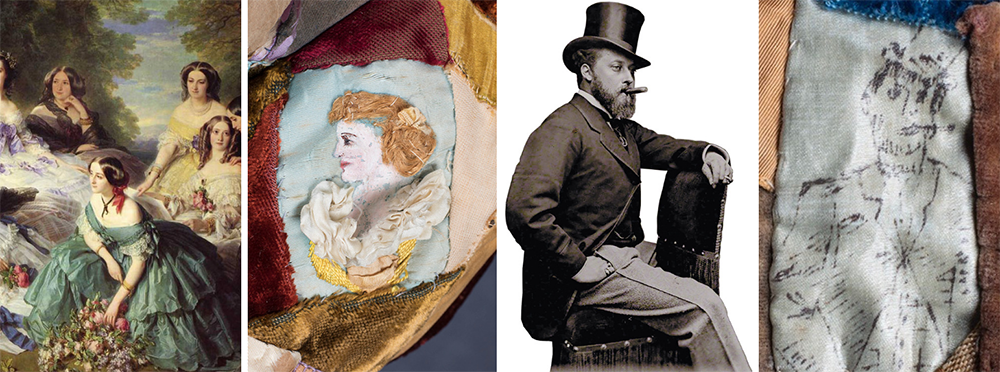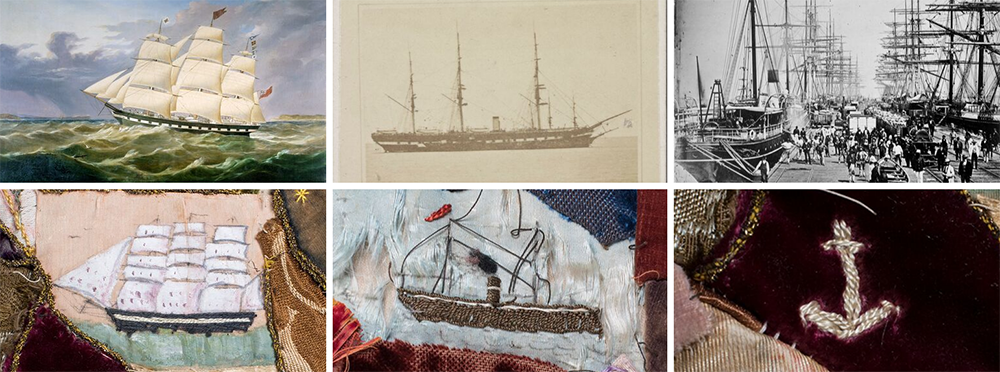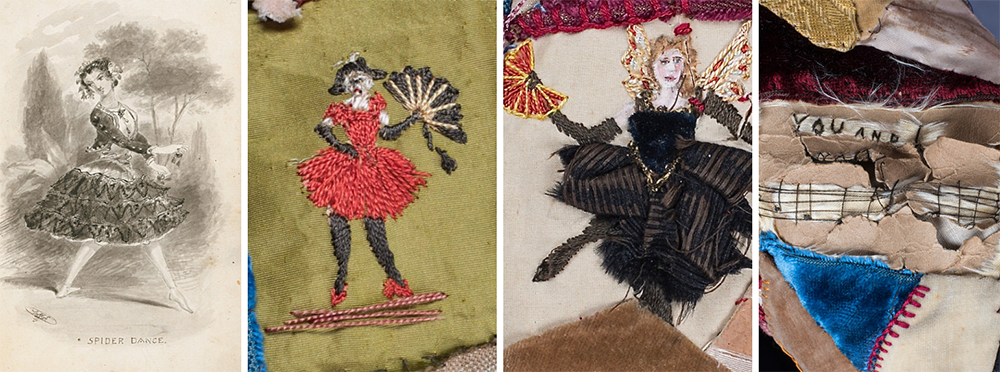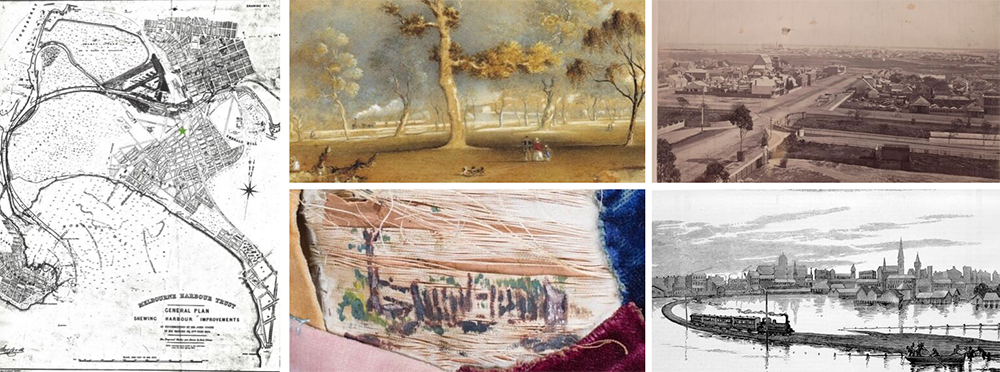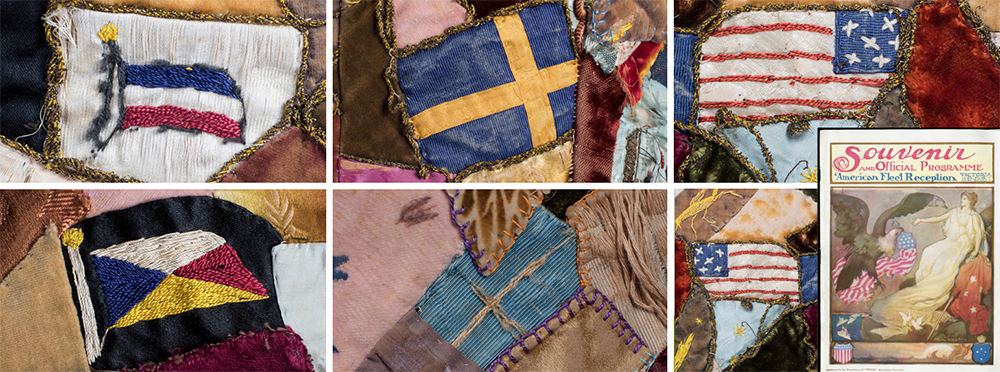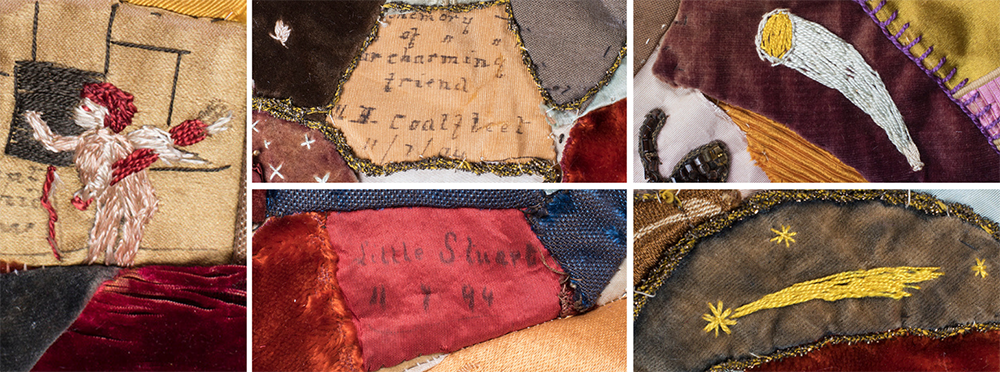
This dressing gown, made from a double bed crazy quilt, shows the work of many hands over many years, from around 1860 to 1915. Initiated by the family of Emerald Hill hoteliers William and Polly Hodgens, the quilt became a communal work featuring contributions from relatives, friends and guests. Together, they filled the colourful patchwork with images and figures from their everyday lives, offering us a unique insight into both the journey of the Hodgens family and the comings and goings of early Melbourne.
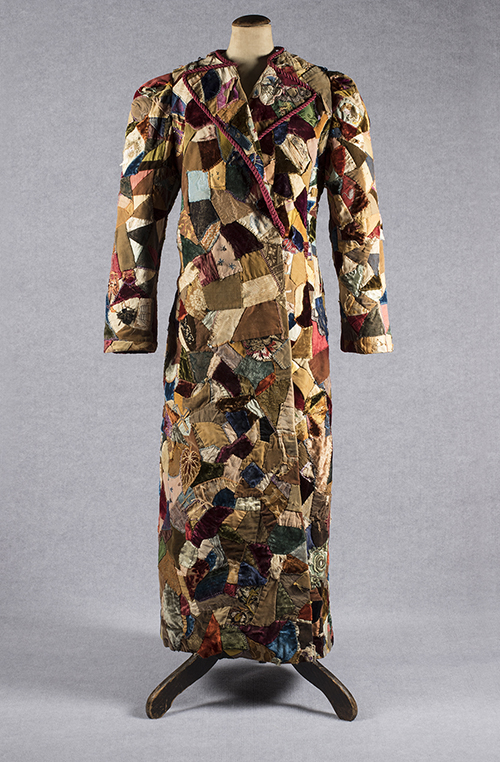 |
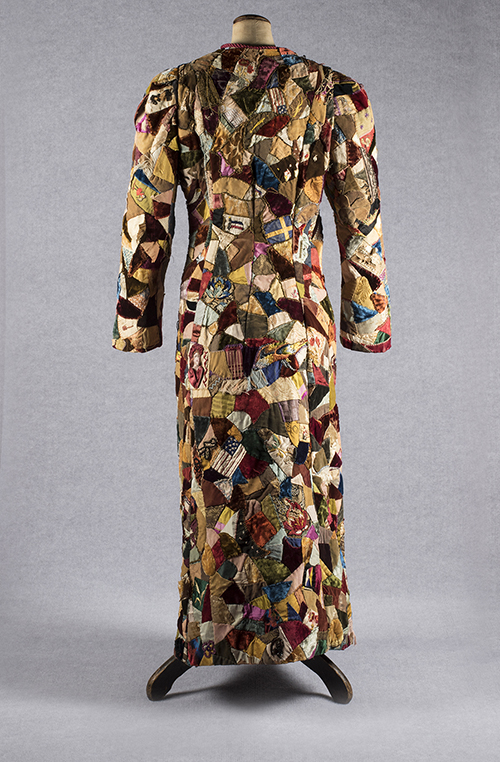 |
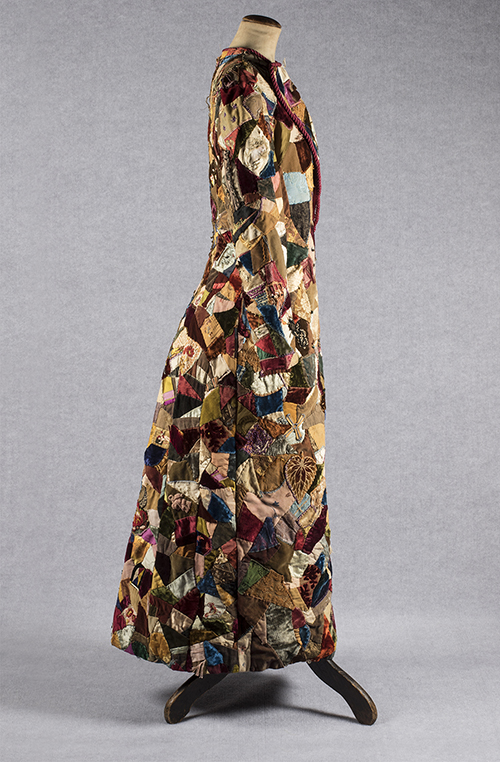 |
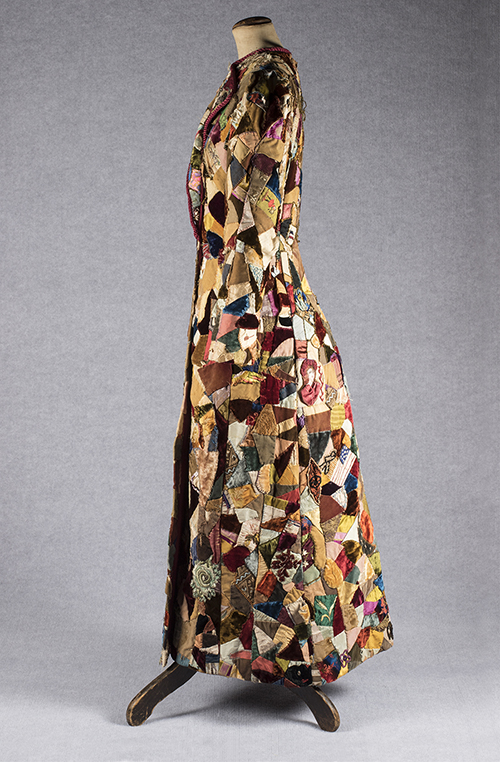 |
| Dressing gown, c. 1860-1915 silk, satin, velvet, paper Brighton Historical Society |
|||
A journey
Design aspects of this quilt suggest its construction may date from as early as 1860, a significant time period for the Hodgens family. In 1861, Irish emigrant William Hodgens and and English emigrant Mary Ellen (Polly) Aymer married in the Victorian gold town of Daylesford.
Thousands made the journey to Australia by sailing clipper or auxiliary steamship, an arduous journey of several months. Quilt-making was encouraged aboard ship, the craft having risen in popularity since the 1840s as industrially produced textiles became increasingly affordable. The ‘crazy quilt’ patchwork style became fashionable in the late nineteenth century. These quilts were often constructed of exotic garment remnants such as silk, satin and brocade and embellished with drawing, painting and embroidery.
We know little about the Hodgens’ life in Daylesford, but one infamous figure of the goldfields is seemingly represented in the quilt: an embroidered dancing woman bears a resemblance to international star of the stage Lola Montez. Lola arrived in Sydney in 1855 for a yearlong tour of Australia, including the goldfield towns of Ballarat, Bendigo and Castlemaine, where her erotic Spanish-inspired ‘spider dance’ earned her both notoriety and fervent admirers. Dance halls and music were popular respite from the hard labour of gold mining.
New beginnings
Around 1875, with the gold rush in decline, William, Polly and their five children, Emily, Daniel, Ada, William and Mabel had moved to the prosperous, growing settlement of Emerald Hill and established the Adelphi Family Hotel in Ferrars Street, just south of the junction of the St Kilda and Port Melbourne train lines. This close proximity to the train line offered commercial opportunity with access to people, industry and shipping. In 1886 William applied for a victualler license, which would allow him to supply food, beverages and provisions to shipping crews.
Businesses essential to the basic needs of a growing community were soon established nearby, including J. Kitchen & Sons’ soap and candle factory, an abattoir, boiling down works, manure and glue factories. Residential areas were set aside, with low-cost housing constructed. Designed to attract “persons of the artisan class”, “labourers, firemen, boilermakers, mariners and shipwrights”, these “neat two roomed cottages and land” were set upon flood-prone mudflats alive with insects and wildflowers.
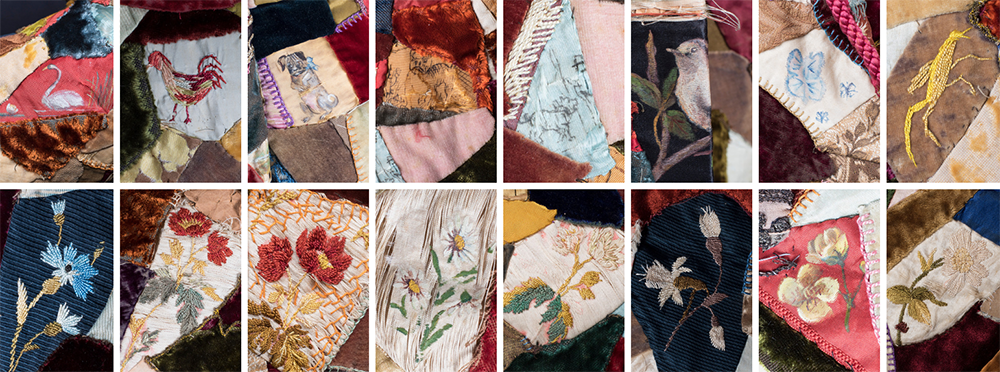 |
|
Dressing gown details: Wildlife, domestic pets and wildflowers in and around Emerald Hill |
Life and community in Emerald Hill
By 1883 William and Polly had nine children. The last four, Alfred, Helen, August and Eulalie, were born in Emerald Hill after 1875, with little Helen passing away in her first year. The completed hotel offered ten rooms for guests in addition to those occupied by the family and staff.
In following years, the family’s daughters invited friends and guests to contribute to the continued creation and decoration of the quilt, recording people, events and surroundings. Particularly striking are several painted portraits, which are credited to daughter Ada Hodgens and feature human hair.
Far-flung countries are represented and bereavements and celebrations recorded. When two Hodgens sons established a brewery business, “Bravo”, in Warrnambool around 1896, the occasion was marked with several embroidered patches – as was the appearance of Halley’s Comet, on its 75-year visitation cycle, in 1910.
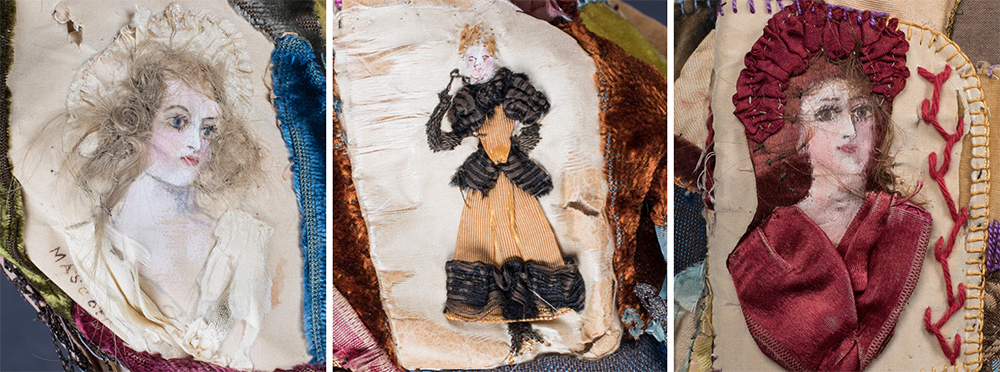 |
|
Dressing gown details: portraits of women |
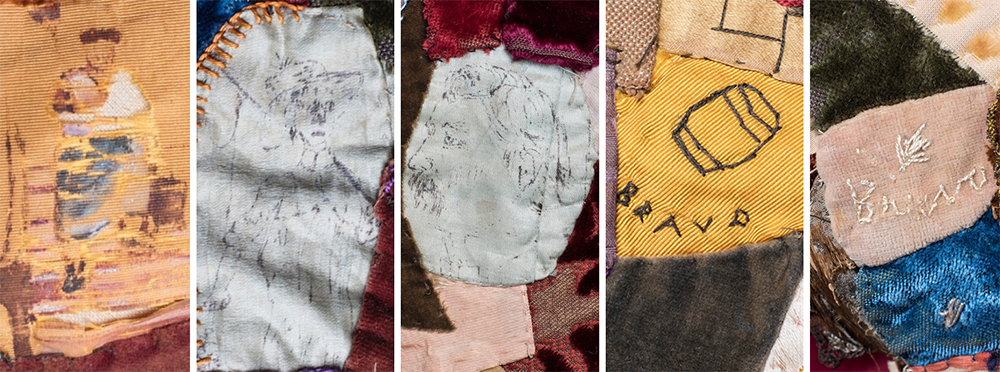 |
|
Dressing gown details: people and work |
The close of an era
Records show that Polly Hodgens remained in charge of the hotel as late as 1913. She died soon after in 1915, with William following in 1916. Family lore states that around this time the pub was sold to the Railway Corporation as part of further rail development. The quilt was passed through the family, reinvented into a dressing gown in the 1970s, before ultimately finding its way to the Brighton Historical Society archives.
The legacy
Through an act of shared craft, we get a sense of how individuals might have connected within a community. In this way, a simple quilt becomes a record of belonging to a certain place in time, a gift to the future offering an image of early Melbourne.
Annabel Butler, 2019
Page design by Jessica Curtain
References
‘Announcements’, The Australasian, 1 December 1883, p. 11, https://trove.nla.gov.au/newspaper/article/138647594
‘History of Rail in Australia’, Australian Government: Department of Infrastructure, Transport, Cities, and Regional Development, https://www.infrastructure.gov.au/rail/trains/history.aspx
‘Victorian Railway History 1839 – 1899’, Australian Railway Historical Society Victorian Division Inc, https://www.arhsvic.org.au/rail-history/victorian-railways-history-1839-1899
‘Victorian Railway History 1900 – 1924’, Australian Railway Historical Society Victorian Division Inc, https://www.arhsvic.org.au/rail-history/victorian-railways-history-1900-1949
Brick, Cindy, Crazy Quilts: History, Techniques, Embroidery Motifs, Voyager Press, St Paul, 2008
Capper, John, The Emigrant’s Guide to Australia, George Philip & Son, Liverpool, 1853, excerpted at State Library South Australia, http://www.slsa.ha.sa.gov.au/BSA/1853ImmigrantsGuide.htm
Carroll, Brian, Melbourne, An Illustrated History, Lansdowne Press, Melbourne, 1972
City of Port Phillip , ‘History of Port Phillip’, City of Port Phillip Heritage, https://heritage.portphillip.vic.gov.au/People_places/History_of_Port_Phillip
City of Port Phillip, ‘Montague the Lost Community’, City of Port Phillip Heritage, https://heritage.portphillip.vic.gov.au/People_places/Significant_places_in_Port_Phillip/Montague_The_Lost_Community
Dabbs, Christine, Crazy Quilting: Heirloom Quilts: Traditional Motifs and Decorative Stitches, Rutledge Hill Press, England, 2000
‘Arthur Wesley Hughes’, Discovering Anzacs, https://discoveringanzacs.naa.gov.au/browse/person/220130
Gilmour, Joanna, ‘You Beauty’, National Portrait Gallery, 1 September 2010, https://www.portrait.gov.au/magazines/37/you-beauty
Grogan, Robert, ‘A brief history of South Melbourne’, Streets of South Melbourne, 2007, https://streetsofsouthmelbourne.wordpress.com/a-brief-history-of-south-melbourne/
Montano, Judith, Elegant Stitches: An Illustrated Stitch Guide and Source Book of Inspiration, C&T Publishing, California, 1995
‘Journeys to Australia’, Museums Victoria, https://museumsvictoria.com.au/longform/journeys-to-australia/
‘Sandridge Railway Trail’, Museums Victoria, https://museumsvictoria.com.au/railways/pdf/sandridge_railway_trail.pdf
‘Crazy quilt no. 913AK’, National Quilt Register, https://www.nationalquiltregister.org.au/quilts/crazy-quilt-23/
‘The “Night Owls” on Tour’, Prahran Chronicle, 25 April 1896, p. 4, https://trove.nla.gov.au/newspaper/article/165213797
Public Record Office Victoria, ‘Railway Pier c1872’, Flickr, 4 August 2015, https://www.flickr.com/photos/public-record-office-victoria/20084152278/
‘Emerald Hill Police Court’, The Record and Emerald Hill and Sandridge Advertiser, 29 December 1876, p. 3, https://trove.nla.gov.au/newspaper/article/108500000
‘Annual Licensing Meeting’, The Record and Emerald Hill and Sandridge Advertiser, 5 December 1879, p. 3, https://trove.nla.gov.au/newspaper/article/108501818
Sands & McDougall’s Melbourne and suburban directories
Sovereign Hill Museums Association, ‘Lola Montez and her Notorious Spider Dance’, Culture Victoria, 2011, https://cv.vic.gov.au/stories/a-diverse-state/lola-montez-star-attraction/lola-montez-and-her-notorious-spider-dance/
‘Shipboard: the 19th Century emigrant experience’, State Library New South Wales, https://www.sl.nsw.gov.au/stories/shipboard-19th-century-emigrant-experience-2
‘Vicfix: Halley’s Comet’, State Library Victoria, https://www.slv.vic.gov.au/contribute-create/vicfix/halleys-comet
‘St Kilda Railway Station (Former)’, Victorian Heritage Database, 2008, https://vhd.heritagecouncil.vic.gov.au/places/66553/
Victorian Post Office Commercial Directory, 1891-2
Waugh, Andrew, ‘Victorian Railway Maps 1860 – 2000’, Victorian Railways Resource, http://www.vrhistory.com/VRMaps/.
Acknowledgements
This research was funded by a Local History Grant from Public Record Office Victoria.
Brighton Historical Society Costume Collection Project, 2018-2019.

